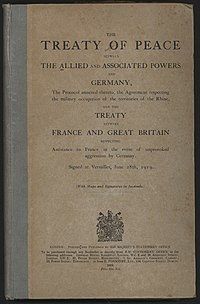Lawrence Y. Sherman
Sherman is best known for his role in preventing the ratification of the Treaty of Versailles, which kept the United States out of the League of Nations.
[3] He studied law under Judge Henry Horner and Professor Samuel H. Deneen and was admitted to the bar in Illinois in 1882.
[8] He served as president of the Illinois state board of administration, public charities, 1909-1913 before returning to the practice of law in Springfield.
[11][12][13] Three months after the primary, the United States Senate invalidated the election of Lorimer and declared the seat vacant.
As one of the group of senators known as the "irreconcilables" or the "bitter-enders", Sherman opposed the ratification of the Treaty of Versailles and of U.S. involvement in the League of Nations, and according to Historian Aaron Chandler, played a key role in its defeat.
[23] He opposed any league that would limit America's sovereignty,[22] and believed that membership in a league of nations with divergent interests would weaken the United States in foreign affairs, by giving equal votes to small, weak countries, and allowing them to join together and dictate foreign policy to the United States, Great Britain, France, and Italy.
He criticized the provisions of Article 7 that would give to the British Empire, counting its colonies, six votes, while the United States would have only one.
[25] He said that "Great Britain with her diplomatic influence in the Old World much superior to ours could easily secure a majority of the nations to outvote us any time she wished.
"[24] He argued that the large number of predominately Catholic nations in the League were dominated by the Vatican, which would leave the United States beholden to the Pope in foreign affairs.
After its defeat, Sherman delivered an address he called "a funeral oration over the defunct remains" of the treaty, and said it was one of the few times that he found himself in agreement with Wilson.
In 1924 Sherman moved to Daytona Beach, Florida, and continued the practice of law there, also engaging in the investment business.
He helped organize the First National Bank of Daytona Beach and served as its president in 1925 and was chairman of its board of directors from 1925 to 1927.
He died in Daytona Beach, Florida, on September 15, 1939, and was interred at Faunce Cemetery in Montrose, Illinois.


